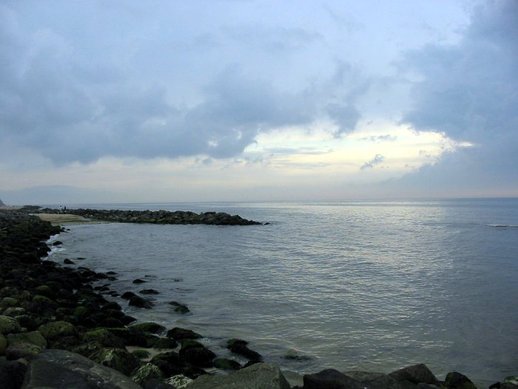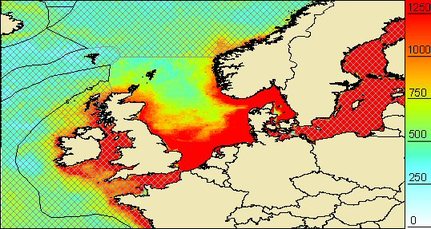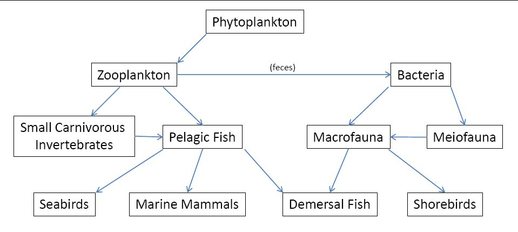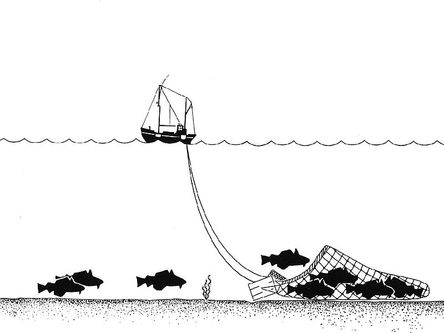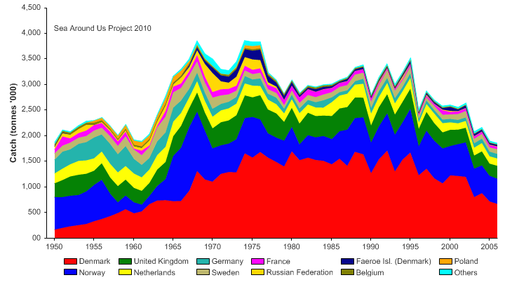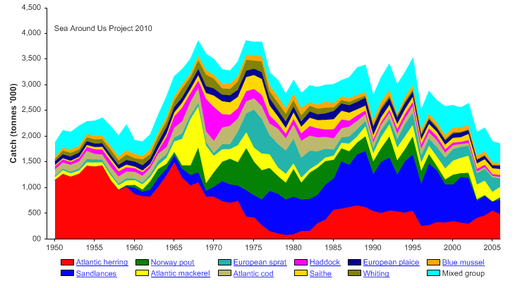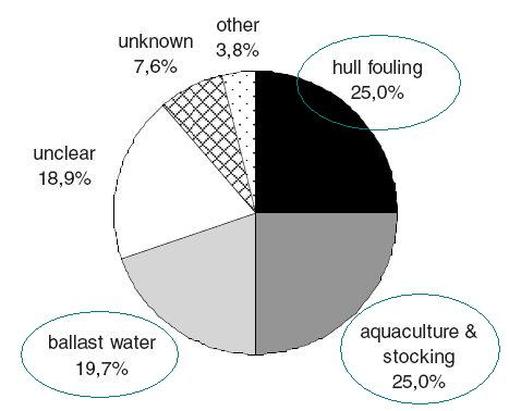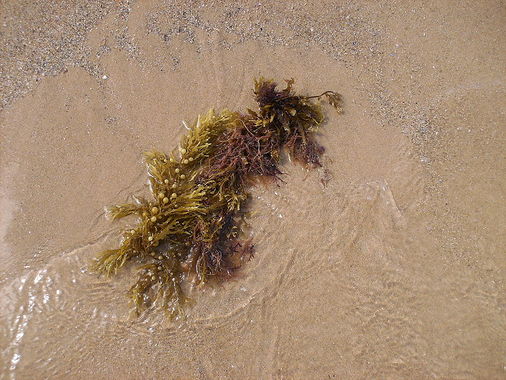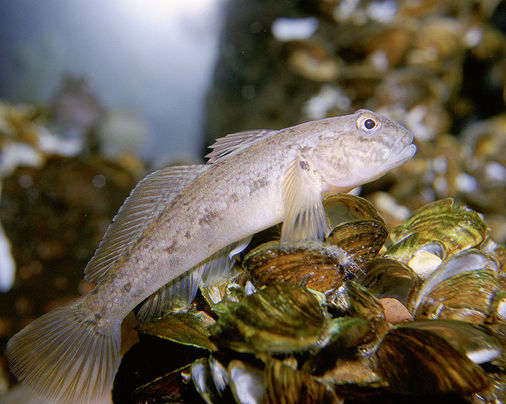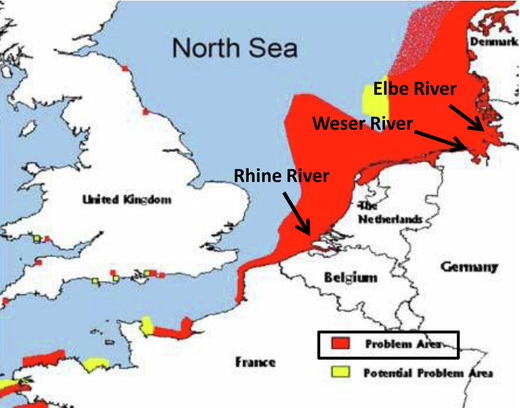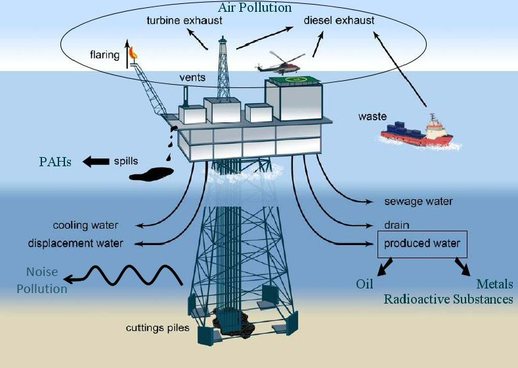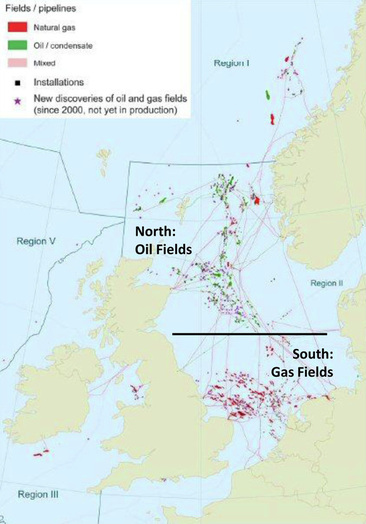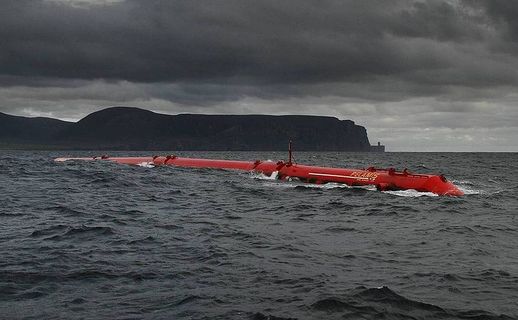North Sea
Introduction
The North Sea in Europe is a productive and diverse sea with a lot of history. For centuries, it has been exploited for its plentiful fish, oil, and gas resources. Its coasts have been modified to suit the needs of humans as the population size has increased. Because of the intense exploitation and modification that has occurred in this region over a long period of time, there are many environmental issues that affect the North Sea and need to be resolved in order to preserve what is left of this important ecosystem.
Table of Contents
- Basic Information
- Biodiversity
- Food Webs and Major Organisms
- Historical Use
- Habitat Changes
- Major Fisheries
- Fisheries Management
- Introduced Species
- Pollution
- Energy Exploitation
- Potential Solutions
- References
Basic Information
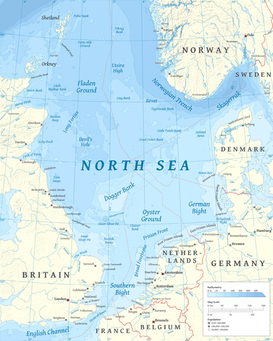
Map of North Sea region [2]
The North Sea is located on the continental shelf of northwestern Europe. It is bordered by the United Kingdom, Norway, Sweden, Denmark, Germany, the Netherlands, Belgium, and France [1].
The North Sea covers an area of over 700,000 km^2. It has an average depth of about 95 meters and a maximum depth of about 700 meters, which occurs along the Norwegian Trench [1][2]. The southern region of the sea tends to be shallower than the northern region [1].
The salinity ranges from 32-35 ppt in most regions of the North Sea, but can be as low as 10 ppt near the Baltic Sea, which drains into it [1][2]. The mean sea surface temperature (SST) is 9.5 °C and is increasing at a rate of about 0.6 °C/100 years [2].
The climate of the North Sea is strongly influenced by the inflow of water from the Atlantic Ocean and strong westerly winds [1][2]. The North Sea is characterized by large variations in wind speed and direction, high levels of cloud cover, and high precipitation [2].
The North Sea covers an area of over 700,000 km^2. It has an average depth of about 95 meters and a maximum depth of about 700 meters, which occurs along the Norwegian Trench [1][2]. The southern region of the sea tends to be shallower than the northern region [1].
The salinity ranges from 32-35 ppt in most regions of the North Sea, but can be as low as 10 ppt near the Baltic Sea, which drains into it [1][2]. The mean sea surface temperature (SST) is 9.5 °C and is increasing at a rate of about 0.6 °C/100 years [2].
The climate of the North Sea is strongly influenced by the inflow of water from the Atlantic Ocean and strong westerly winds [1][2]. The North Sea is characterized by large variations in wind speed and direction, high levels of cloud cover, and high precipitation [2].
Biodiversity
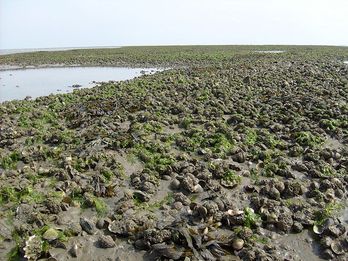
Mudflat in the Wadden Sea [3]
Habitats
The North Sea has a wide variety of habitats associated with it. These include, but are not limited to, sandbanks, mudflats, rocky areas, islands, marshes, and estuaries [3]. The North Sea has around 90 estuaries. The two estuaries that provide the greatest input of freshwater to the North Sea are the Rhine-Maas and the Elbe [4].
Organisms
With such a variety of habitats available for organisms, there are many species that make a living in the North Sea. According to McGlade, an estimated 500 species of phytoplankton live in the Wadden Sea (a small sea located within the North Sea) alone. There are also estimated to be around 300 species of zooplankton. There are a large amount of benthic species, including meiofauna and macrofauna. Together, there are 224 species of fish and crustaceans. There are also 110 species of birds and 16 species of marine mammals that utilize the North Sea [3].
The North Sea has a wide variety of habitats associated with it. These include, but are not limited to, sandbanks, mudflats, rocky areas, islands, marshes, and estuaries [3]. The North Sea has around 90 estuaries. The two estuaries that provide the greatest input of freshwater to the North Sea are the Rhine-Maas and the Elbe [4].
Organisms
With such a variety of habitats available for organisms, there are many species that make a living in the North Sea. According to McGlade, an estimated 500 species of phytoplankton live in the Wadden Sea (a small sea located within the North Sea) alone. There are also estimated to be around 300 species of zooplankton. There are a large amount of benthic species, including meiofauna and macrofauna. Together, there are 224 species of fish and crustaceans. There are also 110 species of birds and 16 species of marine mammals that utilize the North Sea [3].
Food Web and Major Organisms
Major Organisms
The phytoplankton in the North Sea tends to be dominated by diatoms and dinoflagellates, but changes according to the season [3]. The plankton is largely supplied by incoming water from the Atlantic Ocean [2]. The North Sea produces an average of 1115 mg C/m^2/day. For comparison, the EEZ of the west coast of the United States, an upwelling system, only produces 855 mg C/m^2/day [4].
The predominant herbivorous zooplankton are copepods [5]. The most dominant meiofauna are nematodes. The macrobenthic fauna includes species of polychaetes, molluscs, and crustaceans. A majority of the fish biomass is comprised of only a few species, most of which are commercially exploited. These species include saithe, haddock, cod, and mackerel [3].
The phytoplankton in the North Sea tends to be dominated by diatoms and dinoflagellates, but changes according to the season [3]. The plankton is largely supplied by incoming water from the Atlantic Ocean [2]. The North Sea produces an average of 1115 mg C/m^2/day. For comparison, the EEZ of the west coast of the United States, an upwelling system, only produces 855 mg C/m^2/day [4].
The predominant herbivorous zooplankton are copepods [5]. The most dominant meiofauna are nematodes. The macrobenthic fauna includes species of polychaetes, molluscs, and crustaceans. A majority of the fish biomass is comprised of only a few species, most of which are commercially exploited. These species include saithe, haddock, cod, and mackerel [3].
Food Web
Like all marine food webs, the food web of the North Sea begins with phytoplankton. Herbivorous zooplankton, such as copepods, consume the phytoplankton. Zooplankton are consumed by small carnivorous invertebrates, like ctenophores, and pelagic fish, like herring. The pelagic fish also consume the small carnivorous invertebrates. Pelagic fish are consumed by seabirds, marine mammals, and demersal fish [5].
The feces of the zooplankton goes to bacteria in the sediment, which are then consumed by the benthic fauna. Macrofauna consume the meiofauna. In turn, the macrofauna are consumed by demersal fish and shorebirds [5]. Of course, humans are at the top of the food chain, exploiting several levels of the food web.
Like all marine food webs, the food web of the North Sea begins with phytoplankton. Herbivorous zooplankton, such as copepods, consume the phytoplankton. Zooplankton are consumed by small carnivorous invertebrates, like ctenophores, and pelagic fish, like herring. The pelagic fish also consume the small carnivorous invertebrates. Pelagic fish are consumed by seabirds, marine mammals, and demersal fish [5].
The feces of the zooplankton goes to bacteria in the sediment, which are then consumed by the benthic fauna. Macrofauna consume the meiofauna. In turn, the macrofauna are consumed by demersal fish and shorebirds [5]. Of course, humans are at the top of the food chain, exploiting several levels of the food web.
Historical Use
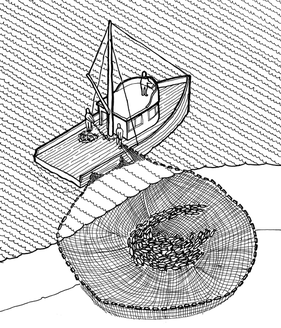
A diagram showing purse seining [6]
History of Fishing
The Dutch were the first people to establish an open-sea fishery in the North Sea. In the 15th century, they were using drift nets to catch herring. Dispute over the sea's resources occurred between the Dutch and the British, until Mare Liberum (1609) declared the freedom of the seas and the right to harvest its resources [3].
Between 1900 and the beginning of WWI in 1914, herring catch reached a peak because of the development of new technologies (i.e. steam vessels). During the war, fishing declined but picked up afterward, although it was never as prominent as it previously was. Similarly, fishing also declined during WWII. After the war, the industrial fishery began to pick up [3].
In 1965, purse seining was introduced to the North Sea, which caused yet another peak in the herring fishery. Herring populations declined rapidly until 1977 when a total ban on herring fishing was imposed. The ban was removed a few years later and herring currently have the highest catch of any species in the North Sea [3].
History of Oil and Gas Exploitation
The North Sea has also been used historically for its rich oil and gas resources. Oil was discovered in 1859 and gas in 1910 [6]. Huge oil discoveries were made in 1959, 1969, and 1970, after years of test drilling, which helped to create a boom in the oil and gas industry in the North Sea [6][7].
The Dutch were the first people to establish an open-sea fishery in the North Sea. In the 15th century, they were using drift nets to catch herring. Dispute over the sea's resources occurred between the Dutch and the British, until Mare Liberum (1609) declared the freedom of the seas and the right to harvest its resources [3].
Between 1900 and the beginning of WWI in 1914, herring catch reached a peak because of the development of new technologies (i.e. steam vessels). During the war, fishing declined but picked up afterward, although it was never as prominent as it previously was. Similarly, fishing also declined during WWII. After the war, the industrial fishery began to pick up [3].
In 1965, purse seining was introduced to the North Sea, which caused yet another peak in the herring fishery. Herring populations declined rapidly until 1977 when a total ban on herring fishing was imposed. The ban was removed a few years later and herring currently have the highest catch of any species in the North Sea [3].
History of Oil and Gas Exploitation
The North Sea has also been used historically for its rich oil and gas resources. Oil was discovered in 1859 and gas in 1910 [6]. Huge oil discoveries were made in 1959, 1969, and 1970, after years of test drilling, which helped to create a boom in the oil and gas industry in the North Sea [6][7].
Habitat Changes
Diking
Around 1000 years ago, according to Reise, the inhabitants along the coast of the Wadden Sea began converting the habitat by diking. The habitat during this time was rich in marsh plants and seagrasses on mudflats and was dependent mostly on phototroph production that occurred within the habitat. After several centuries of habitat use and conversion, the habitat along the Wadden Sea coast has been transformed into one that is dominated by sandy tidal flats and is more dependent on plankton that are supplied from other areas. The present salt marsh area is thought to be about one-tenth of its primordial size [8].
Dredging
Estuaries have been dredged to serve as shipping channels and have lost much of their retention and filtering capacity. As a result, riverine loads flow into the North Sea without being filtered [8]. Three of five estuaries in the Wadden Sea have experienced considerable modification through diking and dredging, which results in few natural transfers of fresh and salt water [9].
Man-Made Structures
The primordial Wadden Sea was relatively free of rocky substrates. Currently, with many stone, concrete, and metal man-made structures in the sea, new hard surfaces have been introduced in the forms of coastal defenses and harbors. These hard surfaces provide a substrate for biota that closely resembles that of natural rocky shores. Overall, however, there has been a decline in natural habitat diversity in the North Sea [8].
Around 1000 years ago, according to Reise, the inhabitants along the coast of the Wadden Sea began converting the habitat by diking. The habitat during this time was rich in marsh plants and seagrasses on mudflats and was dependent mostly on phototroph production that occurred within the habitat. After several centuries of habitat use and conversion, the habitat along the Wadden Sea coast has been transformed into one that is dominated by sandy tidal flats and is more dependent on plankton that are supplied from other areas. The present salt marsh area is thought to be about one-tenth of its primordial size [8].
Dredging
Estuaries have been dredged to serve as shipping channels and have lost much of their retention and filtering capacity. As a result, riverine loads flow into the North Sea without being filtered [8]. Three of five estuaries in the Wadden Sea have experienced considerable modification through diking and dredging, which results in few natural transfers of fresh and salt water [9].
Man-Made Structures
The primordial Wadden Sea was relatively free of rocky substrates. Currently, with many stone, concrete, and metal man-made structures in the sea, new hard surfaces have been introduced in the forms of coastal defenses and harbors. These hard surfaces provide a substrate for biota that closely resembles that of natural rocky shores. Overall, however, there has been a decline in natural habitat diversity in the North Sea [8].
Bottom Trawling
Bottom trawling is a very common and extremely destructive fishing practice in the North Sea. Few areas in the North Sea are undamaged by bottom trawling [9]. It causes alterations in sediment structure, habitat loss, death of benthic organisms, and changes in the composition of benthic communities [1][3][9][10]. Bottom trawling can destroy biogenic habitats, such as mussel and seagrass beds [1]. It is estimated that with each sweep of a trawl, 15-55% of the animals are killed [10]. It also causes long-lived species to be replaced with more short-lived, opportunistic species [3].
Bottom trawling is a very common and extremely destructive fishing practice in the North Sea. Few areas in the North Sea are undamaged by bottom trawling [9]. It causes alterations in sediment structure, habitat loss, death of benthic organisms, and changes in the composition of benthic communities [1][3][9][10]. Bottom trawling can destroy biogenic habitats, such as mussel and seagrass beds [1]. It is estimated that with each sweep of a trawl, 15-55% of the animals are killed [10]. It also causes long-lived species to be replaced with more short-lived, opportunistic species [3].
Major Fisheries
The European Union (EU) fishing industry has 97,000 fishing vessels and 260,000 fishermen. The UK has the largest fishing fleet, in terms of number and capacity, and the most fishermen [3]. Denmark, however, has the largest fleet in terms of catch. Norway, the UK, and the Netherlands follow [3][4]. The gear types most commonly used by North Sea fisheries include trawls (mid-water and bottom), seine nets, purse seines, and gill nets [4].
The North Sea catches around 2-2.5 million metric tons of fish and shellfish each year [3]. Atlantic herring (Clupea harengus) is currently the species with the highest catch. Sandlances (Ammodytes), Atlantic mackerel (Scomber scombrus), and European sprat (Sprattus sprattus) are also caught in high numbers. Fisheries also exist for saithe (Pollachius virens), European plaice (Pleuronectes platessa), and haddock (Melanogrammus aeglefinus), among others [4]. Herring and mackerel are caught for human consumption, while sandlances and sprat are caught for industrial uses (e.g. fish meal) [3].
Fisheries Management
The fisheries in the North Sea are managed by the Common Fisheries Policy, which is put in place by the European Commission (EC). The aim of this policy is to "promote sustainable fisheries and aquaculture in a healthy marine environment which can support an economically viable industry providing employment and opportunities for coastal communities" [11]. The management of fisheries here attempts to respond to both the status of the resources and the market demand [3]. All management decisions follow the commitment of the EU to bring all European fish stocks to a state where they can produce at the maximum sustainable yield (MSY) by 2015 [11].
Total allowable catches (TACs) are set, but are less important now than they previously were because of problems with their enforcement [3][11]. Currently, multi-annual guidance programs (MAGPs) are put into place. These programs have long-term targets that aim to exploit the resources in a sustainable fashion and to assist with the recovery of species when necessary [11]. Recovery plans are an extremely important part of the MAGPs, because most species that are exploited in the North Sea are believed to be seriously depleted [3].
Enforcement of the MAGPs is done by inspectors. The EC has 25 inspectors who make about 130 inspection trips per year. The inspectors are able to choose their missions, so, for example, if they suspect the landings of a particular country are being underreported they can choose to conduct an investigation [11].
Total allowable catches (TACs) are set, but are less important now than they previously were because of problems with their enforcement [3][11]. Currently, multi-annual guidance programs (MAGPs) are put into place. These programs have long-term targets that aim to exploit the resources in a sustainable fashion and to assist with the recovery of species when necessary [11]. Recovery plans are an extremely important part of the MAGPs, because most species that are exploited in the North Sea are believed to be seriously depleted [3].
Enforcement of the MAGPs is done by inspectors. The EC has 25 inspectors who make about 130 inspection trips per year. The inspectors are able to choose their missions, so, for example, if they suspect the landings of a particular country are being underreported they can choose to conduct an investigation [11].
Introduced Species
There are 167 known introduced and cryptogenic species in the North Sea. 38 of those species are classified as cryptogenic because their origins remain unknown. More than two-thirds of introduced species have become widespread and have locally high abundances [12]. Most introduced species are benthic invertebrates [12][13].
Vectors
Most species are introduced into the North Sea through shipping (e.g. hull fouling, ballast water) and intentional introductions for aquaculture [12]. Most invertebrates were introduced through shipping from the west Atlantic, while most algae were introduced from the Pacific with introduced oysters [13].
Examples
Molluscs, such as Mercenaria mercenaria and several Crassostrea species, were intentionally introduced for aquaculture [13]. The brown alga Sargassum muticum was thought to have been introduced to the North Sea via shipments of the Japanese oyster Crassostrea gigas in the 1970s. S. muticum can be a nuisance, as it competes with other macroalgae for space and may clog bays and harbors [9].
Most species are introduced into the North Sea through shipping (e.g. hull fouling, ballast water) and intentional introductions for aquaculture [12]. Most invertebrates were introduced through shipping from the west Atlantic, while most algae were introduced from the Pacific with introduced oysters [13].
Examples
Molluscs, such as Mercenaria mercenaria and several Crassostrea species, were intentionally introduced for aquaculture [13]. The brown alga Sargassum muticum was thought to have been introduced to the North Sea via shipments of the Japanese oyster Crassostrea gigas in the 1970s. S. muticum can be a nuisance, as it competes with other macroalgae for space and may clog bays and harbors [9].
Some species, like the marsh grass Spartina anglica and the amphipod Gammarus tigrinus, were accidentally introduced, but were later deliberately distributed throughout the North Sea region [13]. Other species, like the North American razor clam Ensis americanus and Marenzellaria species of polychaetes, were thought to be introduced by ballast ship water [9]. More recent introductions include the veined rapa whelk Rapana venosa and the round goby Neogobius melanostomus [12].
The ctenophore Mnemiopsis leidyi, known to have caused declines of fisheries in some other seas, has been found in the North Sea [12]. However, to date, there is no evidence that any introduced species, including M. leidyi, have driven any native species to extinction. In fact, it is believed that the main effect of introductions is addition rather than exchange [13].
Pollution
Eutrophication
Eutrophication, or the overenrichment of a body of water with nutrients, is a widespread problem in the North Sea. Effects of eutrophication include increased growth of Ulva, which can form mats. These algal mats have the ability to create anaerobic conditions, which kill fish, and prevent birds from being able to feed. Later stages of eutrophication are associated with algal blooms. Blooms may cause reductions in water clarity, large fluctuations in dissolved oxygen (DO) concentrations, and reductions in biodiversity through invertebrate and fish mortalities. Some algal blooms may be harmful; these cause shellfish poisoning, which can affect fish, birds, and humans [3].
Large rivers are the biggest land-based contributor of nutrient inputs into the North Sea. 65-80% of total nitrogen and 80-85% of total phosphorus comes from large rivers. The main sources of nutrient inputs into large rivers are leaching from agricultural soil and discharge of urban wastewater [1][2][3].
Eutrophication, or the overenrichment of a body of water with nutrients, is a widespread problem in the North Sea. Effects of eutrophication include increased growth of Ulva, which can form mats. These algal mats have the ability to create anaerobic conditions, which kill fish, and prevent birds from being able to feed. Later stages of eutrophication are associated with algal blooms. Blooms may cause reductions in water clarity, large fluctuations in dissolved oxygen (DO) concentrations, and reductions in biodiversity through invertebrate and fish mortalities. Some algal blooms may be harmful; these cause shellfish poisoning, which can affect fish, birds, and humans [3].
Large rivers are the biggest land-based contributor of nutrient inputs into the North Sea. 65-80% of total nitrogen and 80-85% of total phosphorus comes from large rivers. The main sources of nutrient inputs into large rivers are leaching from agricultural soil and discharge of urban wastewater [1][2][3].
Trace Organic Contaminants
Trace organic contaminants, such as polychlorinated biphenyls (PCBs), dichlorodiphenyltrichloroethane (DDT), and tributyltin (TBT), are another source of pollution in the North Sea. Biological effects of these contaminants include decreased reproductive success, increased susceptibility to disease, and reduced survival rates for fish, mammals, and birds. These compounds are found in estuaries, sediments, and the tissues of organisms [3].
High PCB levels can be found in Norwegian fjords and in the river mouths of Germany and Belgium. The concentrations of pesticides in most areas have decreased, but there are still high levels of DDT in some marine species. TBT comes from anti-fouling paint on large vessels. It is present in extremely high concentrations in frequently-used waterways. TBT levels in the water column are 3500 times higher than what is considered safe, while levels in the sediment are 30 million times higher than safe levels [1]. Exposure to this compound has effects on fish reproduction and shellfish growth and has been shown to cause imposex (the development of sexual organs that belong to the opposite sex) in dog whelks [3].
Oil from Land-Based Sources
According to McGlade, most of the oil entering the North Sea comes from land-based sources rather than the industry itself. These sources include ports and harbors, illegal discharges and oil spills, and sewage sludge and waste. Oil contains polycyclic aromatic hydrocarbons (PAHs), which accumulate in the sediments. PAHs can have major impacts on benthic communities by smothering organisms and increasing mortality rates, causing an increase in opportunistic species, and reducing biodiversity [3]. These compounds can also be mutagenic or carcinogenic to fish species. Oil also affects marine birds and mammals by reducing their ability to stay insulated and buoyant [14].
Trace organic contaminants, such as polychlorinated biphenyls (PCBs), dichlorodiphenyltrichloroethane (DDT), and tributyltin (TBT), are another source of pollution in the North Sea. Biological effects of these contaminants include decreased reproductive success, increased susceptibility to disease, and reduced survival rates for fish, mammals, and birds. These compounds are found in estuaries, sediments, and the tissues of organisms [3].
High PCB levels can be found in Norwegian fjords and in the river mouths of Germany and Belgium. The concentrations of pesticides in most areas have decreased, but there are still high levels of DDT in some marine species. TBT comes from anti-fouling paint on large vessels. It is present in extremely high concentrations in frequently-used waterways. TBT levels in the water column are 3500 times higher than what is considered safe, while levels in the sediment are 30 million times higher than safe levels [1]. Exposure to this compound has effects on fish reproduction and shellfish growth and has been shown to cause imposex (the development of sexual organs that belong to the opposite sex) in dog whelks [3].
Oil from Land-Based Sources
According to McGlade, most of the oil entering the North Sea comes from land-based sources rather than the industry itself. These sources include ports and harbors, illegal discharges and oil spills, and sewage sludge and waste. Oil contains polycyclic aromatic hydrocarbons (PAHs), which accumulate in the sediments. PAHs can have major impacts on benthic communities by smothering organisms and increasing mortality rates, causing an increase in opportunistic species, and reducing biodiversity [3]. These compounds can also be mutagenic or carcinogenic to fish species. Oil also affects marine birds and mammals by reducing their ability to stay insulated and buoyant [14].
Oil and Gas Industry
While land-based sources provide the majority of oil to the North Sea indirectly, produced water from oil and gas installations is the largest direct source of oil into the sea [3][14]. Produced water is the water found in the reservoirs along with oil or gas. When it is released into the sea, it may contain oil or gas, which has the same impacts described above. Produced water may also release radioactive substances and metals into the water [14].
The oil and gas industry produces other types of pollution as well. The flaring of oil and gas, as well as exhaust from machinery, produce air pollution. There is also a large amount of noise created by oil and gas installations, which can affect marine mammals and some species of fish [14].
While land-based sources provide the majority of oil to the North Sea indirectly, produced water from oil and gas installations is the largest direct source of oil into the sea [3][14]. Produced water is the water found in the reservoirs along with oil or gas. When it is released into the sea, it may contain oil or gas, which has the same impacts described above. Produced water may also release radioactive substances and metals into the water [14].
The oil and gas industry produces other types of pollution as well. The flaring of oil and gas, as well as exhaust from machinery, produce air pollution. There is also a large amount of noise created by oil and gas installations, which can affect marine mammals and some species of fish [14].
Energy Exploitation
Oil and Gas
As previously mentioned, the oil and gas industry has had a long history in the North Sea. Currently, this industry remains a significant part of the economy in this region and new discoveries are still being made.
As previously mentioned, the oil and gas industry has had a long history in the North Sea. Currently, this industry remains a significant part of the economy in this region and new discoveries are still being made.
In 2009, there were 730 oil and gas installations in the North Sea. Oil exploitation occurs mainly in the northern part of the sea, in the UK and Norwegian sectors. Gas exploitation occurs more so in the southern part of the sea, in the UK, Dutch, and Danish sectors. In 2007, over 200 million metric tons of oil and over 170 million metric tons of gas were produced [14]. Oil and gas production in the North Sea has already peaked and is expected to continue declining for years to come [15].
Along with the aforementioned negative impacts of pollution caused by the oil and gas industry, physical disturbance of the seabed also occurs [14]. These disturbances cause shifts in the structure and composition of benthic communities [16]. Because of the declining oil and gas resources and the many negative impacts this industry has on the environment, there is a movement to become more dependent on renewable energy sources.
Wind Energy
The EU has planned to have 20% of its energy consumption come from renewable sources by 2020. Offshore wind farms are one form of renewable energy source [17].
Offshore wind farms are typically installed in shallow waters less than 25 meters [18]. After installation, the turbine is able to detect wind direction and turn itself to face into the wind so the maximum amount of energy possible is collected. The rotation of the blades powers a generator, which converts the energy into electricity. Cables take the electricity to an offshore transformer, which converts it to a high voltage. After the conversion, the electricity is taken to a station on land [19]. See RenewableUK for a diagram on how offshore wind farms work.
Along with the aforementioned negative impacts of pollution caused by the oil and gas industry, physical disturbance of the seabed also occurs [14]. These disturbances cause shifts in the structure and composition of benthic communities [16]. Because of the declining oil and gas resources and the many negative impacts this industry has on the environment, there is a movement to become more dependent on renewable energy sources.
Wind Energy
The EU has planned to have 20% of its energy consumption come from renewable sources by 2020. Offshore wind farms are one form of renewable energy source [17].
Offshore wind farms are typically installed in shallow waters less than 25 meters [18]. After installation, the turbine is able to detect wind direction and turn itself to face into the wind so the maximum amount of energy possible is collected. The rotation of the blades powers a generator, which converts the energy into electricity. Cables take the electricity to an offshore transformer, which converts it to a high voltage. After the conversion, the electricity is taken to a station on land [19]. See RenewableUK for a diagram on how offshore wind farms work.
The first offshore wind project was installed in 1991 off of Denmark [17]. As of September 2010, the two largest wind farms in the North Sea are Thanet and Horns Rev 2. Thanet is located off of the UK and was completed in September 2010 [20]. Horns Rev 2 is located off of Denmark and was completed in September 2009 [21]. Together, these two farms are able to power over 400,000 households [20][21]. Currently, the EU is studying plans for a transnational power grid that would connect over 100 onshore and offshore wind farms in seven countries and provide power for 70 million households [22].
While wind farms are a renewable energy source and do not produce carbon emissions, they do have some negative impacts on marine animals in the North Sea. They are thought to have the largest impact on birds. Rows of wind turbines act as a barrier to flying birds [23]. Wind farms are essentially a form of habitat loss because they displace birds from important feeding habitats [16]. Noise pollution from wind farms is a potential issue for marine mammals. Like oil and gas installations, wind farms can cause physical disturbance of the sea floor [17].
Wave and Tidal Energy
Other forms of renewable energy, wave and tidal energy, involve using the movement of water as a source of energy. It is estimated that the potential of wave energy is on the order of magnitude of world energy consumption. The potential of tidal energy is also huge, but it is very site-specific; it is only optimized where the tidal range is amplified [24].
While wind farms are a renewable energy source and do not produce carbon emissions, they do have some negative impacts on marine animals in the North Sea. They are thought to have the largest impact on birds. Rows of wind turbines act as a barrier to flying birds [23]. Wind farms are essentially a form of habitat loss because they displace birds from important feeding habitats [16]. Noise pollution from wind farms is a potential issue for marine mammals. Like oil and gas installations, wind farms can cause physical disturbance of the sea floor [17].
Wave and Tidal Energy
Other forms of renewable energy, wave and tidal energy, involve using the movement of water as a source of energy. It is estimated that the potential of wave energy is on the order of magnitude of world energy consumption. The potential of tidal energy is also huge, but it is very site-specific; it is only optimized where the tidal range is amplified [24].
Wave and tidal energy are still in their testing stages. The European Marine Energy Centre (EMEC) currently has two test sites off the Orkney Islands above Scotland. Several companies are testing their various technologies to determine what the most successful method is for developing energy from this source [25].
Because this form of energy production is still in its early stages, it is not well-known what the impacts on wildlife will be. However, it is believed to have a relatively minor effect on the environment [26]. Wildlife observers at EMEC are responsible for observing any possible effects the technologies might have on marine life [25].
Because this form of energy production is still in its early stages, it is not well-known what the impacts on wildlife will be. However, it is believed to have a relatively minor effect on the environment [26]. Wildlife observers at EMEC are responsible for observing any possible effects the technologies might have on marine life [25].
Potential Solutions
Fishing
Overfishing is one of the main issues affecting the North Sea. The MAGPs put in place by the Common Fisheries Policy are a good way of solving this problem. They are also important in assisting with the recovery of depleted species [11]. Strict enforcement, however, is the key to ensuring that the MAGPs are effective.
Bottom trawling is another major issue in the North Sea as it causes habitat loss and changes the structure of communities. Reducing the amount of bottom trawling that occurs across the North Sea and in vulnerable areas of the sea is likely the best solution.
Pollution
There are many things that can be done to reduce the impacts of pollution in the North Sea. Reducing phosphorus and nitrogen inputs into rivers will remove or lessen the threat of eutrophication [27]. Reducing the emissions of hazardous substances, like DDT, will enhance the health of marine organisms [3]. Sewage sludge and waste should be treated more carefully to remove as much oil as possible. More precautions can be taken by the oil and gas industry to ensure that oil and other substances do not leak into the North Sea from produced water.
Overfishing is one of the main issues affecting the North Sea. The MAGPs put in place by the Common Fisheries Policy are a good way of solving this problem. They are also important in assisting with the recovery of depleted species [11]. Strict enforcement, however, is the key to ensuring that the MAGPs are effective.
Bottom trawling is another major issue in the North Sea as it causes habitat loss and changes the structure of communities. Reducing the amount of bottom trawling that occurs across the North Sea and in vulnerable areas of the sea is likely the best solution.
Pollution
There are many things that can be done to reduce the impacts of pollution in the North Sea. Reducing phosphorus and nitrogen inputs into rivers will remove or lessen the threat of eutrophication [27]. Reducing the emissions of hazardous substances, like DDT, will enhance the health of marine organisms [3]. Sewage sludge and waste should be treated more carefully to remove as much oil as possible. More precautions can be taken by the oil and gas industry to ensure that oil and other substances do not leak into the North Sea from produced water.
References
Image References
- North Sea. Wikimedia Commons.
- Map of North Sea region. Wikimedia Commons.
- Mudflat in the Wadden Sea. Wikimedia Commons.
- Annual primary production in the North Sea. Sea Around Us.
- Basic food web of the North Sea. Modified from: Steele, John H. The Structure of Marine Ecosystems. Cambridge: Harvard University Press, 1974.
- A diagram showing purse seining. Wikimedia Commons.
- A diagram showing bottom trawling. Wikimedia Commons.
- Landings by fishing country in the North Sea. Sea Around Us.
- Landings by species in the North Sea. Sea Around Us.
- Atlantic herring (Clupea harengus). Wikimedia Commons.
- Sandlance (Ammodytes). Encyclopedia of Life.
- Atlantic mackerel (Scomber scombrus). Wikimedia Commons.
- European sprat (Sprattus sprattus). Wikimedia Commons.
- Saithe (Pollachius virens). Wikimedia Commons.
- European plaice (Pleuronectes platessa). Wikimedia Commons.
- Haddock (Melanogrammus aeglefinus). Wikimedia Commons.
- Major vectors of introduced species in the North Sea. Modified from: Gollasch, S., D. Haydar, D. Minchin, W.J. Wolff, and K. Reise. "Introduced Aquatic Species of the North Sea Coasts and Adjacent Brackish Waters." Ecological Studies: Analysis and Synthesis. 204 (2009): 507-528.
- Brown alga (Sargassum muticum). Wikimedia Commons.
- Round goby (Neogobius melanostomus). Wikimedia Commons.
- Large rivers creating eutrophication problem areas in the North Sea. Modified from: Claussen, Ulrich, Wanda Zevenboom, Uwe Brockmann, Dilek Topcu, and Peter Bot. "Assessment of the Eutrophication Status of Transitional, Coastal and Marine Waters Within Ospar." Hydrobiologia. 629.1 (2009): 49-58.
- Pollution caused by the oil and gas industry. Modified from: OSPAR Commission. “Assessment of the impacts of offshore oil and gas activities in the North-East Atlantic.” United Kingdom: 2009.
- Oil and gas fields in the North Sea. Modified from: OSPAR Commission. “Assessment of the impacts of offshore oil and gas activities in the North-East Atlantic.” United Kingdom: 2009.
- Thanet offshore wind farm in UK. Wikimedia Commons.
- Wave energy converter. Wikimedia Commons.
Text References
- Environmental Management of Enclosed Coastal Seas. “Environmental Guidebook on the Enclosed Coastal Seas of the World.” 2003.
- OSPAR Commission. “Quality Status Report 2000 for the North-East Atlantic.” 2000.
- McGlade, Jacqueline M. “The North Sea Large Marine Ecosystem.” Large Marine Ecosystems of the North Atlantic: Changing States and Sustainability. Eds. Kenneth Sherman and Hein Rune Skjoldal. Amsterdam: Elsevier, 2002. 339-412.
- Sea Around Us. “LME: North Sea.” http://seaaroundus.org/lme/22.aspx.
- Steele, John H. The Structure of Marine Ecosystems. Cambridge: Harvard University Press, 1974.
- Glennie, K. W. Petroleum Geology of the North Sea: Basic Concepts and Recent Advances. Oxford: Blackwell Science, 1998.
- Pratt, Joseph A., Tyler Priest, and Christopher J. Castaneda. Offshore Pioneers: Brown & Root and the History of Offshore Oil and Gas. Houston, TX: Gulf Pub. Co., 1997.
- Reise, Karsten. "Coast of Change: Habitat Loss and Transformations in the Wadden Sea." Helgoland Marine Research. 59.1 (2005): 9.
- European Environment Agency. “The North Sea: bottom trawling and oil/gas exploitation.”
- Greenpeace. “Our Shrinking Future.” The North Sea: Fisheries Crisis Hot Spot! http://archive.greenpeace.org/comms/cbio/crisis1.html.
- European Commission. “The Common Fisheries Policy: A User’s Guide.” Belgium: 2009.
- Gollasch, S., D. Haydar, D. Minchin, W.J. Wolff, and K. Reise. "Introduced Aquatic Species of the North Sea Coasts and Adjacent Brackish Waters." Ecological Studies: Analysis and Synthesis. 204 (2009): 507-528.
- Reise, K, S Gollasch, and W J. Wolff. "Introduced Marine Species of the North Sea Coasts." (1999).
- OSPAR Commission. “Assessment of the impacts of offshore oil and gas activities in the North-East Atlantic.” United Kingdom: 2009.
- OSPAR Commission. “Offshore Oil and Gas Industry.” http://www.ospar.org/content/content.asp?menu=00120000000056_000000_000000.
- DONG Energy, Vattenfall, The Danish Energy Authority, and the Danish Forest and Nature Agency. “Danish Offshore Wind: Key Environmental Issues.” 2006.
- Department of Energy and Climate Change. “UK Offshore Energy Strategic Environmental Assessment.” 2009.
- European Environment Agency. “Europe’s onshore and offshore wind energy potential: An assessment of environmental and economic constraints.” Copenhagen: 2009.
- RenewableUK. “Offshore Wind: How does an offshore wind farm work?” http://www.bwea.com/offshore/how.html.
- Jessica Shankleman. “UK cuts ribbon on world’s largest offshore wind farm.” 23 Sep 2010. http://www.businessgreen.com/bg/news/1805813/uk-cuts-ribbon-worlds-largest-offshore-wind-farm.
- Matthew McDermott. “Denmark Inaugurates World’s Largest Offshore Wind Farm – 209MW Horns Rev 2.” 17 Sep 2009. http://www.treehugger.com/files/2009/09/denmark-inaugurates-worlds-largest-offshore-wind-farm-horns-rev-2.php.
- David Gow. “Greenpeace’s grid plan: North Sea grid could bring wind power to 70m homes.” The Guardian. 4 Sep 2008.
- S. M. Percival. “Assessment of the Effects of Offshore Wind Farms on Birds.” 2001.
- RenewableUK. “Marine Renewable Energy.” http://www.bwea.com/marine/resource.html.
- European Marine Energy Centre. http://www.emec.org.uk.
- RenewableUK (previously BWEA). “Marine Renewable Energy: State of the Industry Report – October 2009.” 2009.
- Claussen, Ulrich, Wanda Zevenboom, Uwe Brockmann, Dilek Topcu, and Peter Bot. "Assessment of the Eutrophication Status of Transitional, Coastal and Marine Waters Within Ospar." Hydrobiologia. 629.1 (2009): 49-58.
